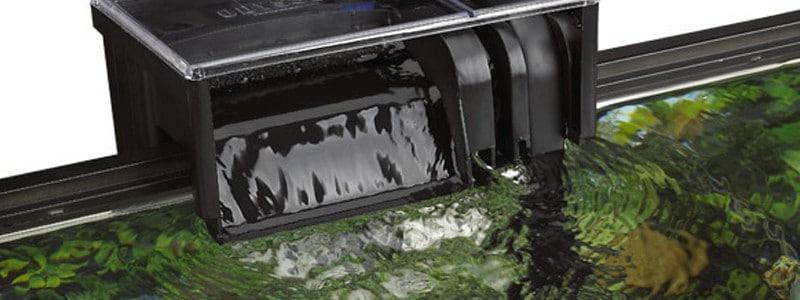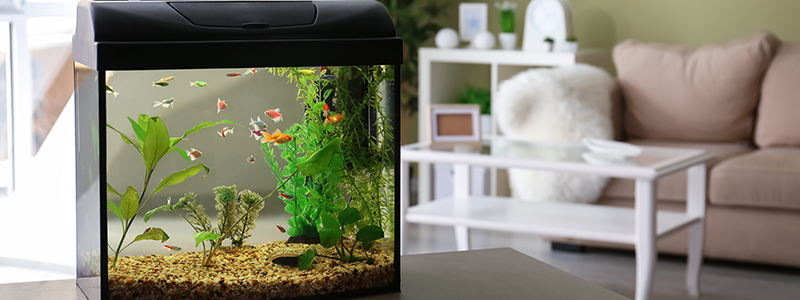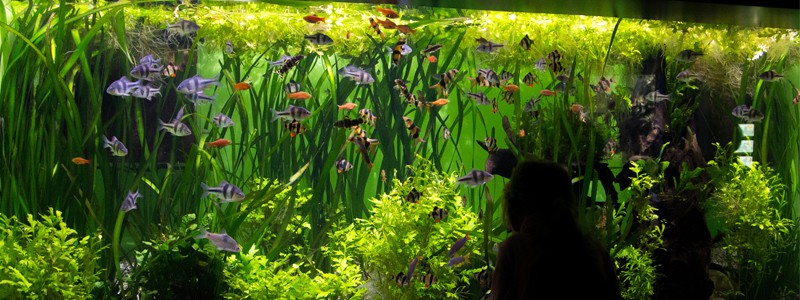A proper aquarium environment involves more than just the right tank and beautiful fish. It requires careful consideration of water quality, where aquarium filters play a vital role.
It can be overwhelming to determine the best aquarium filter for your tank among the many available options. Let’s explore the upsides and downsides of different aquarium filters.
Table of Contents
Canister Filter: Versatile and Efficient
Pros of Canister Filters:
- High Filtration Capacity: Canister filters are known for their superior filtration capabilities. Canister filtration can handle large volumes of water and offer multiple stages of mechanical, chemical, and biological filtration. A canister ensures unmatched water purification.
- Versatility: Canisters are highly versatile and adaptable to various aquarium sizes and setups. They are available in different sizes and can accommodate different types of filter media.
- Customizable Filter Media: Canister filters offer the flexibility to choose and arrange filter media based on your specific filtration requirements. You can incorporate mechanical media, such as sponges and filter pads, to trap debris and particles. Chemical media, such as activated carbon or zeolite, can effectively remove impurities and odors. Additionally, biological media, like ceramic rings or bio-balls, provide ample surface area for beneficial bacteria to thrive and aid in biological filtration.
- Minimal Noise and Aesthetic Concerns: Canister filters are designed to operate quietly, reducing potential noise disruptions in your living space. Since the filter is placed underneath or beside the aquarium, it remains discreet. It does not obstruct the view or take away from the overall aesthetics of your aquarium display.
- Easy Maintenance: Canister filters require less frequent maintenance than other filter types. They often feature convenient shut-off valves that allow you to disconnect the filter for maintenance without disrupting the water flow in the tank.
Cons of Canister Filters:
- Higher Initial Cost: One of the primary drawbacks of canister filters is their higher initial cost than other filter types. Their advanced filtration technology, larger capacity, and additional features make canister filters more expensive. However, the long-term lifespan and benefits they provide often justify the higher investment.
- Regular Maintenance: While canister filters are easy to perform maintenance, they still need periodic maintenance to ensure optimal performance. This includes cleaning the filter media, replacing worn-out media, and regular water changes. Neglecting maintenance can lead to reduced filtration efficiency and potentially compromise water quality.
- Bulky Size: Canister filters are generally larger and bulkier than other filter types, occupying additional space beside or beneath the aquarium. This may pose challenges, especially for smaller aquarium setups or limited space availability.
- The Complexity of Setup: Setting up a canister filter requires technical knowledge and understanding of the equipment. It involves connecting hoses, priming the filter, and ensuring proper sealing to prevent leaks. While manufacturers provide detailed instructions, beginners may still struggle with the setup process.
Canister filters are highly regarded for their exceptional filtration capacity, and versatility. In addition, these filters offer a robust combination of mechanical, chemical, and biological filtration, making them suitable for many aquarium sizes.
In addition, they can accommodate different types of filter media, allowing for customized filtration setups. However, it’s important to note that canister filters require a higher initial investment and regular maintenance for optimal performance.
Power Filters: Simplicity and Effectiveness
- Easy Installation and Maintenance: One of the significant advantages of power filters is their simplicity in installation and maintenance. They typically come with easy-to-follow instructions and require minimal assembly. Hang-on-back filters are designed to be conveniently mounted on the back of the aquarium, making them accessible and easy to maintain.
- High-Tier Mechanical Filtration: Power filters excel in mechanical filtration, efficiently removing debris, uneaten food, and other solid particles from the water. The filter cartridges or media often consist of a combination of mechanical filtration media, such as filter pads or sponges, which trap and physically filter out these impurities.
- Adjustable Flow Rate: Most power filters offer adjustable flow rates, allowing hobbyists to customize the water flow to meet their aquarium’s needs. This feature is handy for adjusting to a specific tank size or those aquariums requiring lower water movement.
- Customizable Media Options: Power filters typically come with replaceable filter cartridges or bags that can be customized with different types of filter media. You can mix and match your media, such as ceramic rings and purigen.
- Versatile for Various Tank Sizes: Power filters are available in different sizes and capacities, making them suitable for many aquarium sizes. Whether you have a small desktop tank or a large aquarium, there is likely a power filter option that will meet your needs.
Cons of Aquarium Power Filters:
- Limited Biological Filtration: While power filters excel in mechanical and chemical filtration, their biological filtration capacity is often weak. The filter cartridges may not provide sufficient surface area for beneficial bacteria to thrive, which is crucial for the aquarium’s biological breakdown of ammonia and nitrite. Supplemental biological filtration may be necessary in heavily stocked tanks, such as a sponge filter.
- Potential Noise: Power filters are known for their waterfalls or cascades, which can create splashing sounds as the water returns to the aquarium. Some hobbyists enjoy the background noise of running water (myself included), others may find it annoying.
- Water Evaporation: Due to the cascading water flow, power filters can increase water evaporation in the aquarium. Make sure to monitor the water level regularly and top up as needed to maintain a stable environment for your aquatic inhabitants.
- Media Replacement Costs: Filter cartridges used in power filters typically require regular replacement to maintain optimal filtration performance. The cost of these replacement cartridges can accumulate over time, especially if you have a larger aquarium or need frequent replacements due to heavy bio-load.
Power filters, commonly known as hang-on-back (HOB) filters, are renowned for their ease of installation and maintenance. In addition, they excel in mechanical and chemical filtration, providing efficient water purification.
With adjustable flow rates and customizable media options, power filters offer flexibility. However, they may lack sufficient biological filtration capacity and can be noisy, especially at higher flow rates. Additionally, additional filtration might be necessary for larger or heavily stocked tanks.
Internal Filters: Compact and Affordable
Pros of Internal Aquarium Filters:
- Cost-Effective Option: Internal filters are generally more affordable than other filtration systems. Their simplicity in design and functionality allows for a cost-effective solution without compromising essential filtration requirements.
- Ultimate Biological Filtration: They offer a surface area for beneficial bacteria to grow, facilitating biological filtration and the breakdown of harmful ammonia and nitrites.
- Easy Installation and Maintenance: Internal filters are known for their user-friendly installation process. They typically come with suction cups or mounting brackets, making them easy to attach to the inside glass of the aquarium. Maintenance is also straightforward, with the filter easily accessible for media cleaning and replacement.
Cons of Internal Aquarium Filters:
- Tank Appeal: Placing the filter inside the aquarium can cause your tank to look cluttered, particularly in smaller tanks or if the filter is not properly sized. This may impact the overall aesthetics of your fish tank setup.
- Filter Movement: The presence of active or larger fish species in the aquarium can occasionally cause internal filters to shift or become displaced. This can disrupt their effectiveness and require readjustment.
- Limited Media Customization: Some internal filters offer limited options for customizing the filter media. They may be specifically designed to accommodate only certain types of filter cartridges or sponge inserts, limiting your flexibility in tailoring the filtration system to your specific needs.
- Weak Mechanical Filtration: In comparison to canister or power filters, internal filters generally provide weaker mechanical filtration capabilities. They are not effective at trapping and removing debris from the water column.
If space or aesthetic is no concern, internal filters offer an affordable filtration solution. These filters are easy to install and maintain, providing biological filtration.
An undergravel filter is an internal filter that offers a cost-effective and straightforward filtration method. They promote biological filtration and provide oxygenation to the aquarium. Ideal for low-maintenance setups, under-gravel filters are easy to use.
However, their filtration capacity could be improved regarding mechanical and chemical filtration. In addition, regular gravel cleaning and maintenance are necessary, and they may not be suitable for tanks with live plants or heavy waste production.
Another internal filter are sponge filters. They are prized for their gentle and biological filtration, making them an excellent choice for fish fry and shrimp tanks. They provide biological and mechanical filtration and are easy to clean and maintain. Sponge filters are can be used on their own or combined with other filtration systems. Depending on your bio-load, mechanical filtration may be needed to upkeep water quality.
Brief Overview: Pros and Cons of Aquarium Canister, Power, and Internal Filters
Cost
Canister Filters: Higher initial cost but often offers long-term cost-effectiveness.
Power Filters: Moderate initial cost with ongoing expenses for replacement cartridges.
Internal Filters: Lower initial cost and affordable maintenance.
Size and Placement
Canister Filters: Larger size, placed under the aquarium.
Power Filters: Medium size, typically hung on the back of the aquarium.
Internal Filters: Placed inside the aquarium.
Filtration Capacity
Canister Filters: High capacity for mechanical, chemical, and biological filtration.
Power Filters: Moderate mechanical and chemical and limited biological filtration capacity.
Internal Filters: High capacity for biological. Low capacity for chemical, and mechanical filtration.
Customization
Canister Filters: Highly customizable with various filter media options.
Power Filters: Moderate customization with replaceable filter cartridges.
Internal Filters: Limited customization with specific filter designs or sponge inserts.
Noise Level
Canister Filters: Generally quiet operation.
Power Filters: These may produce a splashing sound due to the waterfall effect.
Internal Filters: Quiet operation.
Ease of Installation
Canister Filters: Requires some technical knowledge and time for proper setup.
Power Filters: Easy installation; plug and play.
Internal Filters: Simple installation.
Maintenance
Canister Filters: Easy and frequent maintenance, but media replacement and cleaning are required.
Power Filters: Regular maintenance, including filter cartridge replacement and occasional cleaning.
Internal Filters: More frequent maintenance, mainly water changes.
Tank Setups
Canister Filters: Larger tanks or heavily stocked aquariums.
Power Filters: Medium-sized tanks, beginner-friendly setups, and those requiring moderate filtration.
Internal Filters: Smaller tanks, smaller fish, and low to medium bio-load setups.
Conclusion
The right aquarium filter maintains a healthy and vibrant aquatic ecosystem. Each type of filter has their own set of advantages and drawbacks. Canister filters offer versatility and high filtration capacity but require regular maintenance. Power and HOB filters are easy to install and maintain but may lack extensive biological filtration. Internal filters are compact and budget-friendly but have limited capacity.
Undergravel filters provide simplicity and oxygenation, while sponge filters offer gentle filtration. By understanding the pros and cons of different aquarium filters, you can make an informed choice that aligns with your aquarium’s requirements, ensuring a thriving underwater world. It’s essential to consider factors such as tank size, the needs of your aquatic inhabitants, and your maintenance preferences when selecting an aquarium filter.
Ultimately, the ideal aquarium filter will depend on your specific circumstances and goals. Canister filters are popular for larger tanks and those seeking comprehensive filtration. Power and HOB filters are commonly used for their ease of use and effectiveness in maintaining water clarity. Internal filters are favored for their compact design and affordability, making them suitable for smaller setups. Undergravel filters are simple and cost-effective, while sponge filters provide gentle filtration for delicate species.




